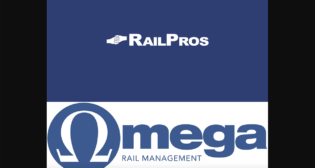
‘Strengthening the Port System and Rail Safety in Canada Act’ Debuts
Written by Marybeth Luczak, Executive Editor
Canada Minister of Transport Omar Alghabra. (Photograph Courtesy of the Minister, via Twitter)
Canada Minister of Transport Omar Alghabra on Nov. 17 introduced the Strengthening the Port System and Railway Safety in Canada Act, which he said “includes measures to improve our supply chain so that our transportation system remains safe, efficient and reliable.”
The government is taking action as existing supply chain issues have been “exacerbated by extreme climate events, changes in trade patterns and Russia’s invasion of Ukraine,” Transport Canada explained.
It said the Strengthening the Port System and Railway Safety in Canada Act aims to:
- “Amend current legislation and modernize the way Canada’s marine and railway transportation systems operate.
- “Remove systemic barriers to create a more fluid, secure and resilient supply chain.
- “Expand Canada Port Authorities’ mandate over traffic management.
- “Position Canada’s ports as strategic hubs that support national supply chain performance and effectively manage investment decisions for sustainable growth.
- “Improve the government’s insight into ports and their operations.
- “Modernize provisions on rail safety, security and transportation of dangerous goods.”
The proposed legislative amendments respond to the now-complete Railway Safety Act Review, Transport Canada said, “by seeking to strengthen rail safety and security in Canada through an updated framework.” The amendments seek to “improve transparency and efficiency; address gaps and emerging challenges; and further improve the safety and security of the various modes of movement of dangerous goods throughout Canada.”
Following is Transport Canada’s summary of the proposed amendments for railroads:
- “Enhanced transparency and collaboration: These measures would improve the transparency and efficiency of the rail safety oversight framework through the modernization of key regulatory processes. Amendments to the Railway Safety Act would seek to: Allow the Minister to request any relevant information when assessing rule exemption requests; [p]rovide the Minister the ability to consult broadly in rule decision-making; [r]equire a review of the Railway Safety Act on a five-year cycle, ensuring an adaptive legislative framework.
- “A more efficient rail network: As technologies evolve, these amendments would ensure that the Canadian rail system is poised to adapt in kind. This will promote a more efficient, and thereby stronger, supply chain. Amendments to the Canada Transportation Act would seek to: Provide for the use of automated systems in decision-making; [e]xpressly authorize the use of telecommunications by Transport Canada inspectors, investigators and enforcement officers for the purpose of verifying compliance or preventing non-compliance with other Acts for which the Minister of Transport is responsible. Amendments to the Railway Safety Act would seek to: Provide more flexibility associated with rules and exemptions. This will support the continued fluidity and efficiency of rail operations while reducing administrative burden.
- “Modernized oversight of railway operations: This element would ensure an appropriate and up-to-date rail safety and security framework by bringing certainty to planning and decision-making for the rail industry and enable effective enforcement and compliance with rail safety and security provisions. Amendments to the Railway Safety Act would seek to: Provide a broad definition of ‘safety’ to include ‘security’ throughout the Act; [a]uthorize the Minister of Transport to negotiate assurances of compliance and enter into compliance agreements before or after the issuance of an Administrative Monetary Penalty; [a]dd prohibitions related to unruly or dangerous behavior on-board trains or at stations; and unlawful interferences such as tampering, and destructive acts with railway operations; [p]rovide authorities to require railway companies to create security management systems and for the Minister to order corrective measures regarding those systems; [c]reate the authority for the Minister of Transport to grant, cancel and suspend transportation security clearances under the Railway Safety Act.”
Additionally, Transport Canada reported that amendments to the Transportation of Dangerous Goods Act, 1992 “would seek to: Modify and provide new Ministerial and inspector authorities to provide greater flexibility to address ongoing and emergency safety risks; [c]reate an Administrative Monetary Penalties regime to address a significant enforcement gap in the Transportation of Dangerous Goods Program; [c]reate a client registration requirement to provide Transport Canada with a reliable and comprehensive inventory of stakeholders who import, offer for transport, handle, or transport dangerous goods in Canada.”
The bill will also “allow the government of Canada to deliver on the completion of the Ports Modernization Review by enabling Canada’s ports to better respond to an increasingly complex economic, social and environmental operating environment,” according to Transport Canada. Within this context, it noted, “the government of Canada recognizes that: private investment will continue to be central to our ports having world-class facilities and services, and it will continue to welcome investment as a catalyst for growth and innovation; a clear and predictable investment climate is key to enabling investors to play this important role; and taking steps to make sure investments support supply chain fluidity will help Canadians get the goods they need, when they need them, at an affordable cost.”
For this reason, a new policy statement on port investment is being advanced, according to Transport Canada. It sets out “a clear set of principles to guide government decisions,” the application of which “would be enabled by new legislative tools being advanced under the proposed bill.”
In sum, the bill “represents the culmination of efforts undertaken over numerous years as part of the Railway Safety Act Review, the Ports Modernization Review and Transport Canada’s work related to the transportation of dangerous goods,” Transport Canada reported. “These actions will help establish a strong foundation for our transportation system that will build on the National Supply Chain Task Force’s recommendations, particularly around the efficient operation of Canada’s ports.”
The Strengthening the Port System and Railway Safety in Canada Act has been tabled in the House of Commons, and now must go through the parliamentary stages and the senate, according to a report in The Canadian Press.
“We are at the phase of our National Supply Chain Strategy where we can start focusing on creating real and tangible change,” Alghabra said. “Today’s [Nov. 17] proposed legislative amendments are the result of years of hard work, including reviews and numerous consultations considering the various factors that affect supply chain issues and the lives of Canadians. The work to date will greatly contribute to a long-term strategy that will benefit Canadians and our economy for years to come.”



